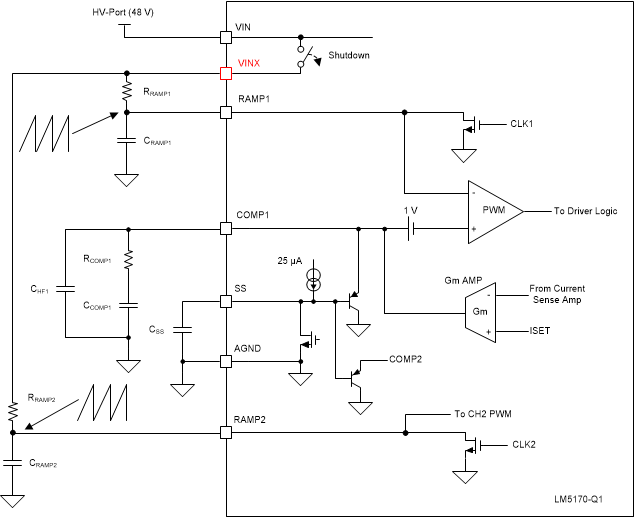ZHCSFO3D November 2016 – August 2021 LM5170-Q1
PRODUCTION DATA
- 1 特性
- 2 应用
- 3 说明
- 4 Revision History
- 5 说明(续)
- 6 Pin Configuration and Functions
- 7 Specifications
-
8 Detailed Description
- 8.1 Overview
- 8.2 Functional Block Diagram
- 8.3
Feature Description
- 8.3.1 Bias Supply (VCC, VCCA)
- 8.3.2 Undervoltage Lockout (UVLO) and Master Enable or Disable
- 8.3.3 High Voltage Input (VIN, VINX)
- 8.3.4 Current Sense Amplifier
- 8.3.5 Control Commands
- 8.3.6 Channel Current Monitor (IOUT1, IOUT2)
- 8.3.7 Cycle-by-Cycle Peak Current Limit (IPK)
- 8.3.8 Error Amplifier
- 8.3.9 Ramp Generator
- 8.3.10 Soft Start
- 8.3.11 Gate Drive Outputs, Dead Time Programming and Adaptive Dead Time (HO1, HO2, LO1, LO2, DT)
- 8.3.12 PWM Comparator
- 8.3.13 Oscillator (OSC)
- 8.3.14 Synchronization to an External Clock (SYNCIN, SYNCOUT)
- 8.3.15 Diode Emulation
- 8.3.16 Power MOSFET Failure Detection and Failure Protection (nFAULT, BRKG, BRKS)
- 8.3.17 Overvoltage Protection (OVPA, OVPB)
- 8.4 Device Functional Modes
- 8.5 Programming
-
9 Application and Implementation
- 9.1 Application Information
- 9.2
Typical Application
- 9.2.1
60-A, Dual-Phase, 48-V to 12-V Bidirectional Converter
- 9.2.1.1 Design Requirements
- 9.2.1.2
Detailed Design Procedure
- 9.2.1.2.1 Determining the Duty Cycle
- 9.2.1.2.2 Oscillator Programming
- 9.2.1.2.3 Power Inductor, RMS and Peak Currents
- 9.2.1.2.4 Current Sense (RCS)
- 9.2.1.2.5 Current Setting Limits (ISETA or ISETD)
- 9.2.1.2.6 Peak Current Limit
- 9.2.1.2.7 Power MOSFETS
- 9.2.1.2.8 Bias Supply
- 9.2.1.2.9 Boot Strap
- 9.2.1.2.10 RAMP Generators
- 9.2.1.2.11 OVP
- 9.2.1.2.12 Dead Time
- 9.2.1.2.13 IOUT Monitors
- 9.2.1.2.14 UVLO Pin Usage
- 9.2.1.2.15 VIN Pin Configuration
- 9.2.1.2.16 Loop Compensation
- 9.2.1.2.17 Soft Start
- 9.2.1.2.18 ISET Pins
- 9.2.1.3 Application Curves
- 9.2.1
60-A, Dual-Phase, 48-V to 12-V Bidirectional Converter
- 10Power Supply Recommendations
- 11Layout
- 12Device and Documentation Support
- 13Mechanical, Packaging, and Orderable Information
8.3.9 Ramp Generator
Refer to Figure 8-7 for the circuit block diagram of the ramp generator, gm error amplifier, PWM comparator, and soft-start control circuit. The VINX pin serves as the supply pin for the ramp generator. Each ramp generator consists of an external RC circuit (RRAMP and CRAMP) and an internal pulldown switch controlled by the clock signal.
 Figure 8-7 Error Amplifier, Ramp Generator, Soft Start, and PWM Comparator
Figure 8-7 Error Amplifier, Ramp Generator, Soft Start, and PWM ComparatorWhen the LM5170-Q1 is enabled, CRAMP1/2 is charged by the VINX pin through RRAMP1/2 at the beginning of each switching cycle. The internal pulldown FET discharges CRAMP1/2 at the end of the cycle within a 200-ns internal, then the pulldown is released, and CRAMP1/2 repeats the charging and discharging cycles. In general the RAMP RC time constant is much greater than the period of a switching cycle. Therefore, the RAMP pin voltages are sawtooth signals with a slope proportional to the HV-Port voltage. In this way the RAMP signals convey the line voltage info. Being directly used by the PWM comparators to determine the instantaneous switching duty cycles, the RAMP signals fulfill the line voltage feedforward function and enable the LM5170-Q1 to have a fast response to line transients.
TI recommends users to select appropriate RRAMP and CRAMP values by the following equation such that the RAMP pins reach the peak value of approximately 5 V each cycle when VIN is at 48 V.

For instance, if Fsw = 100 kHz, and CRAMP1 = CRAMP2 = 1 nF, a resistor of approximately 96 kΩ should be selected for RRAMP1 and RRAMP2.
Because CRAMP1/2 must be fully discharged every cycle through the 15-Ω channel resistor of the pulldown FET within the 150-ns minimum discharging interval, CRAMP1/2 should be limited to be less than 2.5 nF nominal at room temperature.
There is also a valid RAMP signal detection circuit for each channel to prevent the channel from errantly running into the maximum duty cycle if RAMP goes away. It detects the peak voltage of the RAMP signal. If the peak voltage is less than 0.6 V in consecutive cycles, it is considered an invalid RAMP and the channel will stop switching by turning both HO and LO off until the RAMP signal recovers. This 0.6-V voltage threshold defines the minimum operating voltage of the HV-Port to be approximately 5.76 V.